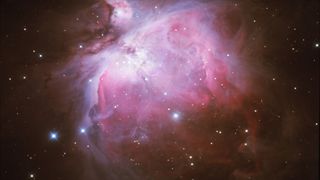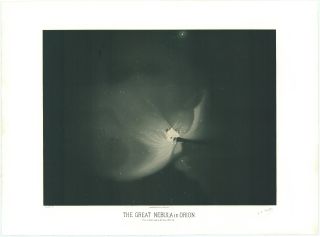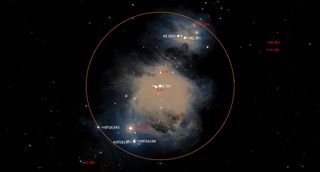
Shining down upon us all winter long, Orion is the brightest and grandest of all the constellations.
Dominating our winter evening skies is the Great Hunter or Celestial Warrior the most brilliant of the constellations and visible from every inhabited part of the Earth. This season, Orion can readily be found standing high in the southern sky at nightfall and doesn't completely set until around 1:30 a.m. Throughout March, the Hunter will begin to move westward. Three bright stars in a diagonal line in the middle of a bright rectangle decorate Orion's belt which points northward to the bright orange star Aldebaran of Taurus, and southward to the Dog Star, Sirius.
Within Orion we find two immense stars, Rigel and Betelgeuse, apparently at two entirely different periods in a star's existence. In Rigel (the "Left Leg of the Giant"), we find a star apparently reaching the prime of its life. Betelgeuse ("The Armpit of the Giant") in contrast, shines with a cool, dull ruddy hue; an irregular pulsating supergiant star, nearing the end of its life and as such it expands and contracts spasmodically.
Read more: Orion Constellation: Facts, location and stars of the hunter
Alluring cloud of gas and dust

Looking for a telescope to see the stars of the Orion constellation up close? We recommend the Celestron Astro Fi 102 as the top pick in our best beginner's telescope guide.
But undoubtedly one of the most wonderfully beautiful objects in the night sky is the Great Orion Nebula, also known as M42. It appears to surround the middle star of the three stars that lie below the Hunter's belt between its 'legs.'
Plainly visible to the naked eye under a dark sky, it can be clearly resolved in good binoculars and small telescopes — even from urban areas — as a bright gray-green mist enveloping the star.
In larger telescopes it appears as a great glowing irregular cloud; there is considerable detail with branches, rifts and rays. A sort of auroral glow is induced in this nebula by fluorescence from the strong ultraviolet radiation of four hot stars called the "Trapezium," entangled within it. In 1929, amateur astronomer, William T. Olcott wrote: "Words fail utterly to describe its beauty."

The Great Orion Nebula is a vast cloud of extremely tenuous glowing gas and dust, approximately 1,600 light-years away and about 30 light-years across (or more than 20,000 times the diameter of the entire solar system). Astrophysicists now believe that this nebulous stuff is a stellar incubator; the primeval chaos from which star formation is presently underway.
Get the Space.com Newsletter
Breaking space news, the latest updates on rocket launches, skywatching events and more!

Painting outdoes photograph
Everyone who has viewed M42 agrees that no photograph they had seen compared in splendor to what appeared in the eyepiece. Its complex, gossamer-like structure is indeed an eyeful, but photographs often "burn-out" the inner region of the nebula and obscure the Trapezium stars. In 1880, using M42 as his subject, Henry Draper (1837-1882), known as a pioneer of astrophotography, was the first person to successfully photograph a nebula.
In 1875, during his stay at Harvard Observatory, French artist and astronomer Étienne Léopold Trouvelot (1827-1895) captured almost to perfection, the remarkable detail of the Great Orion Nebula. Interestingly, he didn't draw it merely by "eyeballing." Instead, Trouvelot used a grid of squares in the eyepiece and then meticulously copied the details onto squared paper. In addition, there are many other sky objects which he depicted such as solar eclipses, comets and the Milky Way, which made him known worldwide as one of the finest artists of celestial objects during the late 19th century.
But these beautiful renditions were not the only legacy that Trouvelot brought to our shores.

If you want to check out the Orion nebula for yourself, our guides for the best telescopes and best binoculars are a great place to start. It doesn't take much to be able to see many of the deep space wonders of the night sky!
And if you're looking to snap your own gorgeous photos of the night sky, check out our guide on how to photograph the moon, as well as our best cameras for astrophotography and best lenses for astrophotography.

A scorned legacy
Besides being an astronomer and artist, Trouvelot was also an amateur entomologist. In 1869 he had a wild idea to produce silk more cheaply by crossing the silkworm with the spongy moth.
You might know the latter insect better by its former name, the gypsy moth, but in March 2022, The Entomological Society of America formally adopted the new name, spongy moth. This change was necessary because the word 'gypsy' is considered a derogatory term for the Romani people. The moth's new moniker, is derived from the common name used in France and French-speaking Canada, "spongieuse," and refers to the moth's sponge-like egg masses.
So Trouvelot imported some live egg clusters to his home in Medford, Massachusetts for experimentation. He failed, but some of the creatures escaped and after a decade began to proliferate alarmingly; over the next century, spreading throughout New England, the Mid-Atlantic, Greater Ohio Valley, Piedmont and southern Great Lakes, to the point where late-spring infestations periodically cover forests and houses with hairy caterpillars that denude oak tree foliage as they produce their "silk."
I saw this firsthand several years ago when my own property endured an invasion of spongy moths and as a consequence, I lost several majestic hardwood trees. Today this pest is listed as one of the 100 most destructive invasive species worldwide.
No question about it. Trouvelot should have stuck to astronomy!
Joe Rao serves as an instructor and guest lecturer at New York's Hayden Planetarium. He writes about astronomy for Natural History magazine, the Farmers' Almanac and other publications. Follow us on Twitter @Spacedotcom and on Facebook.
Join our Space Forums to keep talking space on the latest missions, night sky and more! And if you have a news tip, correction or comment, let us know at: community@space.com.

Joe Rao is Space.com's skywatching columnist, as well as a veteran meteorologist and eclipse chaser who also serves as an instructor and guest lecturer at New York's Hayden Planetarium. He writes about astronomy for Natural History magazine, the Farmers' Almanac and other publications. Joe is an 8-time Emmy-nominated meteorologist who served the Putnam Valley region of New York for over 21 years. You can find him on Twitter and YouTube tracking lunar and solar eclipses, meteor showers and more. To find out Joe's latest project, visit him on Twitter.
-
rod M42 is an excellent telescope target. I use 90-mm refractor and 10-inch Newtonian telescopes. Some great views. Rigel a great double star, 71x does the job very nice or higher power. Since 12/16/22 thru 02/23/23, I logged 5 views of M42. Large arc and nebulosity all around. In my 10-inch at 150x, I can see 5 stars in the Trapezium. I do not use nebula filters. When I did, fainter stars were obscured in the nebulosity. Do I see colors? No, mostly gray/grayish-white areas and very dark nebula cloud outlines. However, M42 is a wonderful sight in my 90-mm refractor telescope and 10-inch Newtonian, especially using a 2-inch, low power eyepiece.Reply -
murgatroyd Good article! 👍Reply
(I criticize space.com articles that are flawed, so it's only fair to praise a well-written one.)